
For simplicity, we will examine a traditional roller coaster, where the cars are lifted to the top of only the first hill by a mechanical device under the cars; thereafter the cars move only under the influence of gravity and friction. Obviously for a coaster of this type, the higher the first hill, the more action will be possible later in the ride. The total energy available to the cars is the potential energy given to them by lifting them to height h. This is given by the formula: You can calculate how fast the cars will be moving at the bottom of a hill by using the kinetic energy formula: So at the bottom: 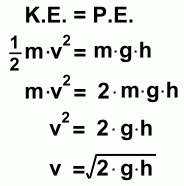 This calculation shows how to derive the formula for the speed of the cars after they have fallen height h. Notice that the formula does not contain a value for m, which means that the speed reached by the cars does not depend on their mass, or on the mass of the riders. (Remember, we're ignoring friction).
This calculation shows how to derive the formula for the speed of the cars after they have fallen height h. Notice that the formula does not contain a value for m, which means that the speed reached by the cars does not depend on their mass, or on the mass of the riders. (Remember, we're ignoring friction).The value g is the acceleration due to gravity, or about 9.8 m/s2 Because some of the original potential energy gets changed to heat, due to friction with the track, the actual value for v will be a bit smaller than this. As the cars continue up the next hill and this speed gets changed back to potential energy, the little bit that was lost will mean that the cars cannot return to their original height, so the next hill can't be quite as tall. As the cars on the roller coaster reach the bottom of a hill and start back up, you will feel heavier. This is because your reaction to the centripetal acceleration caused by the cars' changing direction is added to the acceleration due to gravity. In terms of forces, your reaction to the centripetal force applied to you and the cars as they turn upwards is added to the force of gravity, making you heavier. Let's try and make this clearer with a picture. 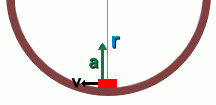 Your car is moving to the left at the bottom of a hill, with speed v. The hill's radius is r. (For simplicity, we'll assume it's a circular valley).
Your car is moving to the left at the bottom of a hill, with speed v. The hill's radius is r. (For simplicity, we'll assume it's a circular valley). The centripetal acceleration caused by this turn upwards is a, and its formula is given by: The direction of any centripetal acceleration is always toward the centre of curvature; in this case, upwards. This centripetal acceleration upwards causes a force to be applied to you and the car. It's the centripetal force, and it's upwards. But this is the force applied to you that forces you to change direction; Newton's First Law says that there is an equal but opposite force downwards. It's sometimes called centrifugal force, and it's the force you feel as the car pushes upwards on you at the bottom of the hill ... it feels like a downward force. This force gets added to the force of gravity (also downwards), making you feel heavier. The value of the acceleration due to gravity is 9.8 m/s2. This is one g. Additional 'weight' may be added to the rider as the cars pass through the bottom of a hill, and may be several multiples of g. These are known as g forces. 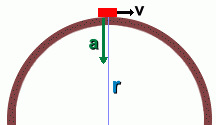 Exactly the opposite happens as you go over the top of a hill. The safety bars on the car push downwards, holding you in the car. This is the centripetal force. What you experience is the equal but opposite upwards force (centrifugal force).
Exactly the opposite happens as you go over the top of a hill. The safety bars on the car push downwards, holding you in the car. This is the centripetal force. What you experience is the equal but opposite upwards force (centrifugal force).Since this acts upwards, opposite to gravity, it will make you feel lighter. In fact, if the centripetal (and centrifugal) force is large enough to exactly equal your weight, you will feel weightless. This is how astronauts practice in weightless conditions, by simulating this effect in an airplane. When you're falling down a steep hill on a roller coaster, you aren't falling freely, even though it may feel like it.
Modern roller coasters are constructed of steel. The added strength of this material allows for twists and loops that weren't possible in older wooden coasters. Let's look at what happens in a loop. 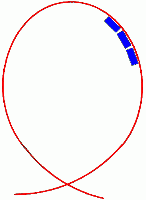 A roller coaster loop is actually a teardrop shape called clothoid. A clothoid is a section of a spiral in which the radius is constantly changing. Unlike a circular loop in which the radius is constant, the radius at the bottom of a clothoid loop is much larger than the radius at the top. A roller coaster loop is actually a teardrop shape called clothoid. A clothoid is a section of a spiral in which the radius is constantly changing. Unlike a circular loop in which the radius is constant, the radius at the bottom of a clothoid loop is much larger than the radius at the top.If you look at the diagram on the right, you'll see that it is very strongly curved at the top, but near the bottom the curvature is much less. As a rider begins to climb the loop, it slows down. This is because an increase in height (an increase in potential energy) results in a decrease in kinetic energy and speed. As the rider comes down the other side, the decrease in height (decrease in potential energy) results in an increase in kinetic energy and speed. The rider experiences the greatest speeds at the bottom of the loop, both upon entering and leaving, and the lowest speeds at the top of the loop. (A 'g' is an acceleration that causes you to feel your normal weight. Eight g's would make you feel 8 times heavier). To eliminate this problem, ride designers make the loops in the shape of a clothoid. This causes a higher centripetal force near the top, and because you are inside the loop, reduces the acceleration to 3 or 4 g's ... enough to make the ride exciting without injuring anyone. Roller coasters can be modelled using plastic or foam half-tubes and a small steel ball. When designing a roller coaster, it will become obvious that higher initial starting points produces a faster-moving ball at the bottom, and that the ball can't be brought to the top of a hill that's taller than the starting point. 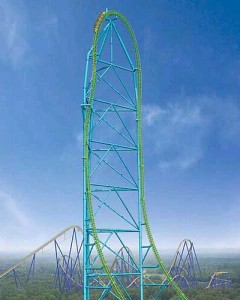 Ever wonder about the world's scariest roller coaster? That distinction once belonged to Kingda Ka, located at Six Flags Great Adventure in New Jersey, USA. At a height of 140 metres, it was the tallest (in 2005) and also unique for its special ride. Cars approach a vertical climb at 200 km/h, and then rise vertically for 140 metres, before coming to a brief stop and then plunging downwards vertically to the bottom, at a speed reaching 200 km/h . Ever wonder about the world's scariest roller coaster? That distinction once belonged to Kingda Ka, located at Six Flags Great Adventure in New Jersey, USA. At a height of 140 metres, it was the tallest (in 2005) and also unique for its special ride. Cars approach a vertical climb at 200 km/h, and then rise vertically for 140 metres, before coming to a brief stop and then plunging downwards vertically to the bottom, at a speed reaching 200 km/h .
Kingda Ka's 200 km/h top speed was also the world's fastest (in 2005). Rather than using a chain drive like most coasters, this one uses a hydraulic launch system, delivering 20,800 horsepower and rocketing the cars to top speed in just 3.5 seconds, much like the way jet planes are launched from the deck of an aircraft carrier. The entire ride, including a stretch near the end that makes you feel weightless as it rises over another 40 metre high rise, takes 50.6 seconds. Kingda Ka cost $25 million dollars (US) to design and build. |
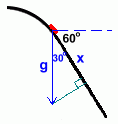 The value of g downwards is 9.8 m/s2
The value of g downwards is 9.8 m/s2